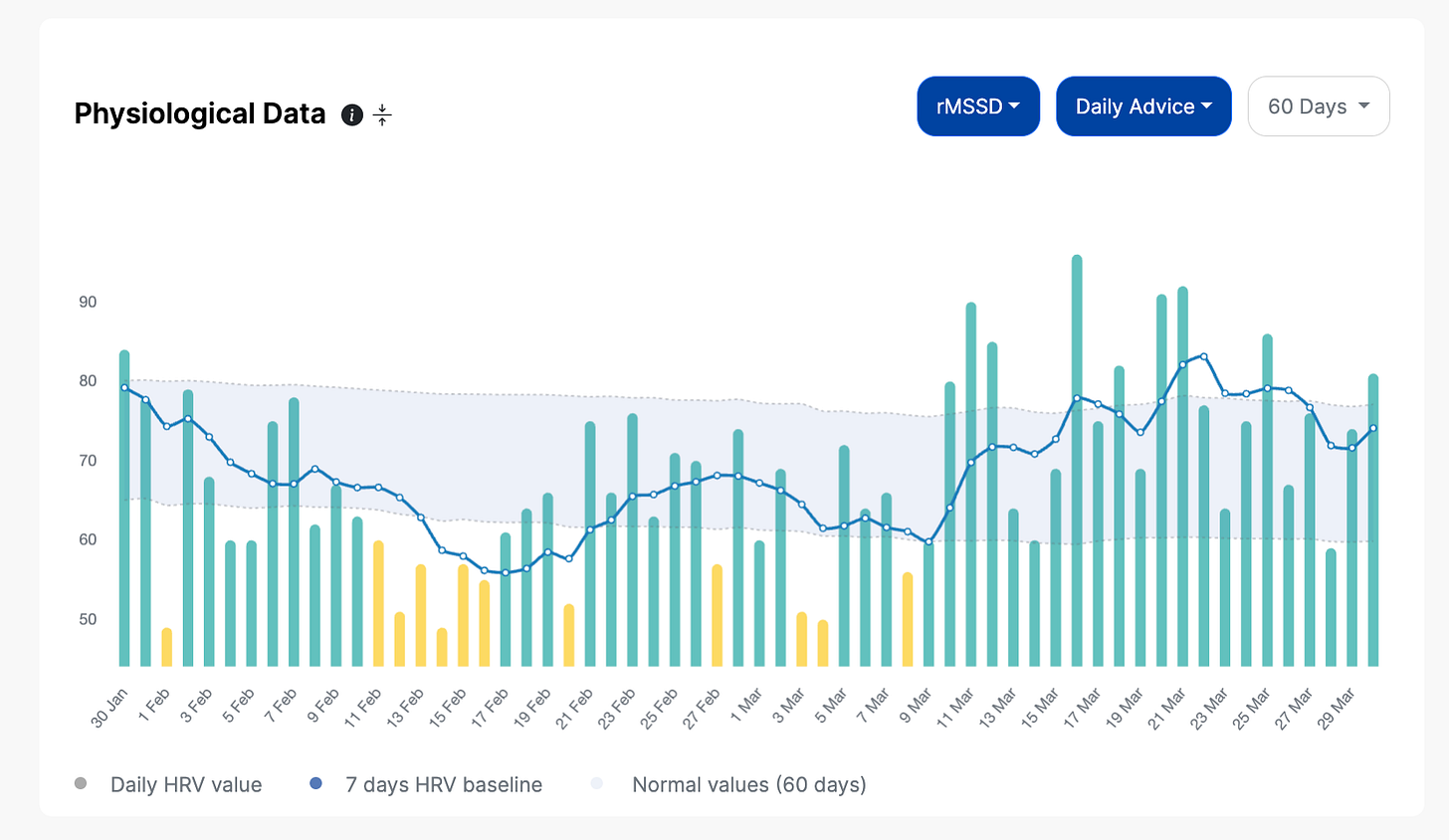March 2023 recap 🗓️
a monthly newsletter
hi there 👋
I hope all is well.
Here is my March recap, broken down by topic, with links to the individual articles.
I hope you’ll find them useful. Please feel free to comment below or in the individual articles should you have any questions, and I will try to follow up.
Heart rate variability (HRV) 🫀
Heart rate variability (HRV) measurement position: lying down, sitting or standing? In the past year, I’ve started recommending measuring HRV while sitting, as opposed to lying down. I came to this conclusion after several conversations with a trusted expert in the field (Andrew Flatt), self-experimentation in different positions over an entire year (so that I could look at the relationship between the data and various acute and chronic stressors), and reading the available literature. I now consider sitting the best and most effective way to capture data. In this post, I elaborate more on why this is the case, covering the rationale, physiological mechanisms, and research and providing some practical recommendations.
Blood flows when the heart beats: similarities and differences in measures of cardiac variability derived using photoplethysmography (PPG) and electrocardiography (ECG). Most sensors these days use a technology called photoplethysmography (PPG) to measure heart rate variability (HRV). For example, phone cameras as used in HRV4Training, or dedicated sensors as present in Oura rings or Garmin watches, all use this technology to capture changes in blood volume during a cardiac cycle, and report HRV. While we use the term HRV, in this context we should be talking about pulse rate variability (or PRV), as what we are actually measuring are PPG-derived changes in pulse rate, not in heart rate. We should be talking about HRV only if we do measure changes in heart rhythm (as opposed to pulse rate), but to do that, we need a different type of technology: electrocardiography (ECG). This is the technology used by more cumbersome devices with sticky gel electrodes or patches, or simply chest straps. The questions I address in this blog are the following: is HRV the same as PRV? Can we use wearables and phone cameras to track HRV? What are the differences and similarities between these two methods?
Ramblings 🤌
Truth or dogma, a journey in the world of heart rate variability. I don’t have all the answers, but I am interested in seeking the truth when it comes to HRV and its application. In this blog you can find a bit of background on my journey, including a few aspects of HRV measurement and analysis where I changed my mind over the years: breathing rate, body position, continuous measurement of HRV, exercise HRV, PPG vs ECG, user-generated data and HRV-guided training.
I’d like to stress this again as continuous HRV measurements are being pushed harder than ever: keep in mind the flaws. Be intentional and thoughtful about your tracking.
Building 🛠️
I have been busy building the new HRV4Training Pro and have started putting together various articles that will serve as a user guide and overview of the various features. You can learn more about the main principles and you can find a user guide where I keep adding as I build. In particular, in the past month I’ve added: resting physiology and trends analysis, training intensity distribution analysis, lactate threshold (critical speed) and race time estimation, VO2max estimation, correlation analysis, and intervals analysis. I’m getting closer to the end and I hope to be able to start beta testing in May.
I am working with Coros to build an integration of their morning ECG feature into HRV4Training. If interested in beta testing, please drop me a line. You will need a Coros watch with ECG functionality and our app.
Training talk 🏃🏻♂️
On March 5th I suffered a hamstring strain in the last 200m of a half marathon, and I blew a PR and also had to skip my sub-3 attempt at the marathon which was planned for two weeks later. Fortunately, it was a minor strain, and I am feeling better and training reasonably well again. Not rushing it, but I might try to squeeze in a sub-3 attempt in Manchester before parking this goal until October.
Training log. As the name says, this is simply my training diary for the year.
I was back in the lab for VO2max and lactate testing, which is always interesting after another year of training (my biggest so far, with 570 hours of running). Brief overview:
VO2max: 59.8 → 62.1 ml/min/kg
lactate curve shifted to the right (LT1 1 km/h faster)
lower HR (8-10 bpm at any speed)
lower breathing rate above LT1
lower cost of running (2681 → 2426 ml/min at 10 km/h)
Full report here.
That’s all for today, see you next month, and thank you for reading!
Marco holds a PhD cum laude in applied machine learning, a M.Sc. cum laude in computer science engineering, and a M.Sc. cum laude in human movement sciences and high-performance coaching.
He has published more than 50 papers and patents at the intersection between physiology, health, technology, and human performance.
He is co-founder of HRV4Training, advisor at Oura, guest lecturer at VU Amsterdam, and editor for IEEE Pervasive Computing Magazine. He loves running.
Social:





Great March recap, keep up the great work in leading the field and educating the public with your knowledge. Thank you.